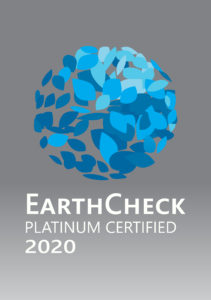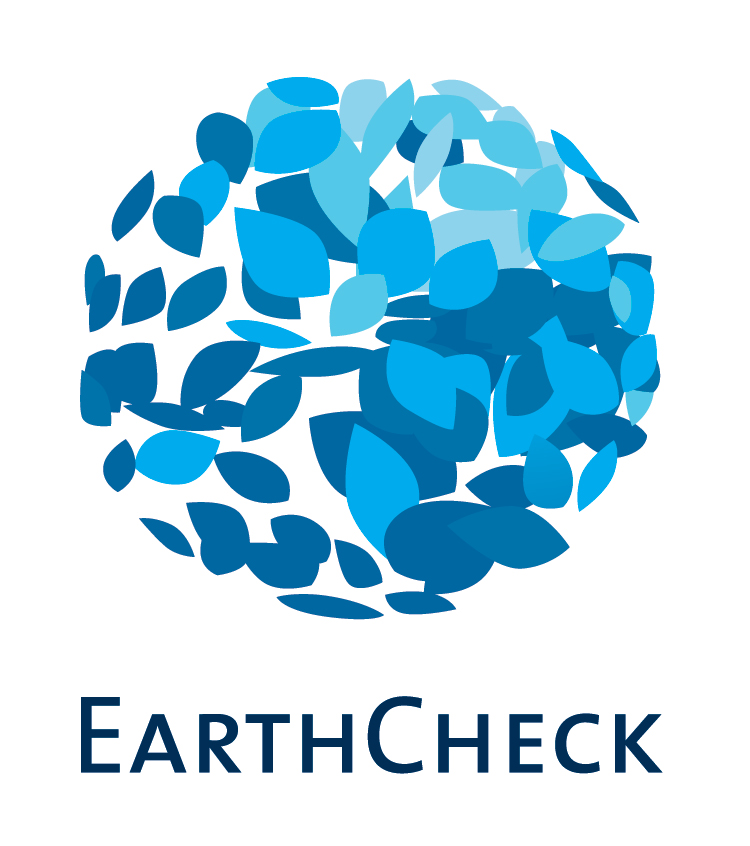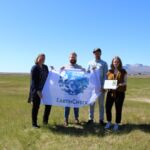 Snæfellsnes Peninsula, a 90 km long Peninsula in West Iceland made up of five municipalities, first joined EarthCheck in 2004. The peninsula is home to just under 4000 residents and is a pure wonder with a long mountain range that ends in Snæfellsjokull glacier (1442m), a glacier that served as a main focus in Jules Verne’s novel ‘Journey to the Center of the Earth’. One of the special natural features on Snæfellsnes are the many different lave fields, basalt columns and the flora and fauna. Unsurprisingly, tourism plays a major role in Snæfellsnes Peninsula with about 80% of the businesses within the destination being defined as tourism businesses. In recent years, Iceland has seen the largest year-on-year increase in the number of foreign travelers on record. In light of the rapidly growing visitor numbers, sustainable destination management has become even more important.
Snæfellsnes Peninsula, a 90 km long Peninsula in West Iceland made up of five municipalities, first joined EarthCheck in 2004. The peninsula is home to just under 4000 residents and is a pure wonder with a long mountain range that ends in Snæfellsjokull glacier (1442m), a glacier that served as a main focus in Jules Verne’s novel ‘Journey to the Center of the Earth’. One of the special natural features on Snæfellsnes are the many different lave fields, basalt columns and the flora and fauna. Unsurprisingly, tourism plays a major role in Snæfellsnes Peninsula with about 80% of the businesses within the destination being defined as tourism businesses. In recent years, Iceland has seen the largest year-on-year increase in the number of foreign travelers on record. In light of the rapidly growing visitor numbers, sustainable destination management has become even more important.
The five municipalities in Snæfellsnes: Eyja- og Miklaholtshreppur, Helgafellssveit, Grundarfjarðarbær, Snæfellsbær and Stykkishólmsbær, have been awarded environmental certification by the EarthCheck organisation. The certification confirms that the region is an environmentally conscious community that systematically strives for improvements in environmental issues in the spirit of sustainable work practices. The certification applies to the activities of the municipalities and the public bodies operated by them. The certification was initially achieved in 2008 after extensive preparations.
The achievement received a great deal of attention, both in Iceland and overseas, as Snæfellsnes is the first community in Europe to be awarded the certification and the fourth in the world.
WHY ENVIRONMENTAL CERTIFICATION?Local communities can reduce waste and pollution with several actions and achieve good results in certain domains without environmental certification. They can, for example, do this with active participation in projects such as Local Agenda 21 (Stadardagskrá 21), or simply on their own terms. Therefore, one could wonder whether seeking environmental certification offers more advantages than other methods.
A key element of an approved certification process includes for instance the evaluation and assessment of an independent entity regarding the efficiency of the certification seeking entity. This is a very important element and there are unequivocal advantages to
building up more sustainable life and work habits with the certification of an independent third party:
- Credibility – Since measurable benefit is estimated by an independent entity and needs to meet defined standards and criteria, it is guaranteed that the benefit considered to be achieved is real and not only subjective.
- Quality control – Participating in a certification process guarantees an accurate record of the use of resources and increases information transparency. Thus, it improves work and paper processes and gives a better overview of the use of natural resources. It therefore promotes better quality control, which facilitates the monitoring of changes and reactions when improvements are needed.
- Discipline and compliance – A yearly evaluation made by the certification body guarantees discipline, compliance and concrete information regarding performance. Therefore, the system is more likely to deliver real steps towards sustainability.
This shows that seeking environmental certification can offer many more advantages than other methods. Furthermore, the environmental certification of an internationally approved certification body can clearly improve the image of the certified entity and bring new and varied opportunities in terms of presentation and marketing.
This project is carried out in cooperation with environmental representatives, employees and inhabitants of local communities, and institutions with activities throughout the country. The information is processed and sent to EarthCheck in Australia who uses them to calculate the performance of local communities in comparison to the established criteria. Consequently, the certification body will publish a report regarding the results for each year (benchmarking report).
Maintaining the certification requires continuous improvements in environmental and community issues. An independent entity annually reviews the operation of the municipalities for the renewal of the certification. An extensive monitoring system for resource use in the area has been established to ensure results and supervision. The system monitors various environmental indicators such as energy and chemical use. It provides a better overview and can be useful in ensuring that we do not encroach on the environment as well as for economizing in operations.
Seeking environmental certification for an activity is a challenge in itself and the path towards a more environmentally friendly community is full of obstacles. Some challenges can be resolved permanently in an easy way, but others are always present since they change as fast as they are tackled.The fact that five local communities and a national park have jointly sought environmental certification increases the challenge even more. The level of complication is increased with the number of independent entities that each have their own board, finances, etc., as well as different opinions on different matters. This may delay the handling process and sometimes it is necessary to
make compromises in order to achieve things. Large areas, widely spread inhabitants and a great number of entities and institutions directly participating in the project can also cause problems, for example because there is not always time for regular, personal communication between managers and employees of the project or between general employees and inhabitants of local communities. However, Snæfellsnes is a significant landscape character area and working with such a large area greatly strengthens the project. The sharing of expertise and work processes clearly brings strength to the project as well. Furthermore, the marketing is much easier for tourism, for example, when it comes to a well limited area that is so rich with nature. The cooperation has generally been a success and everything indicates that this will continue.
The biggest challenge regarding the implementation of the project, which is in fact an international subject matter within the field of environmental protection, has been to mobilize as many people as possible to cooperate with the project. This applies for instance to managers and employees of local communities who have, for the most part, generally been positive towards the
project but who could invest themselves more in it. Generally, it is easier to reach and to have a dialogue with those who are already interested in the policy area, but how about all the others who don‘t seem to care? And how is it possible to have an objective discussion with those who don‘t think there is any need for improvement with regards to environmental issues, without such efforts taking up all the time and energy for the project? This is an ongoing problem that calls for constant development and testing. Different methods are needed to reach different age groups and
it is not sure that the masses can be reached with methods that were suitable 10, 20 or 30 years ago. It also needs to be evaluated how much of the activities of the environmental certification project needs to be directed inwards, in order to improve registration or other factors within the activities of the local communities, and how much should be directed outwards, for presentation and education for inhabitants and others.
The last challenge mentioned here, but nevertheless the most important one in order to increase sustainability, is to achieve real progress regarding moderate use of resources, i.e. to protect air, land and sea from negative environmental effects due to human activity. This is the vision of the local communities in Snæfellsnes that consider the environmental certification project to be a
good way to achieve this goal. In some cases, a great achievement has already been reached but in other cases we need to work better towards improvement. The first steps have been taken, which is very important. It is also important to bear in mind that everyone can have a positive impact. So can we!
It is difficult to quantify the progress made in Snæfellsnes in the last decade to estimate whether they are more important than if this project had not taken place. However, several factors can be pointed out since Snæfellsnes now clearly shows better results than most or all other local communities in Iceland. The establishment of this project has, for example, made accessible and comparable information available with regard to the use of resources, which is a fundamental feature in order to estimate achievement in this field just like in other fields.
The benefits of the project are multiple, but five
elements are specifically emphasized here:
- An environmental management system has been
established. - Promoting less use of resources which brings more
benefits for the environment. - Promoting an increased environmental awareness
among the inhabitants of Snaefellsnes, where a great
change of attitude has taken place following the
establishment of the project. - The area has a good image when it comes to
environmental matters and this can be useful, for
example when it comes to tourism. - A useful base has been built for the future.
The environmental certification project of the local communities in Snaefellsnes is in constant development. Its future vision is that local communities will continue to cooperate in the field of environmental matters. Infrastructures and work processes will continue to be improved. The ideology of sustainable development will be integrated more clearly into the decision making processes, operation and implementation processes of local communities and decisions will be made based on the long-term interests of nature and of the community. Hopefully, this will lead to rapid progress in environmental matters, saving of resources and benefits for nature and environment, for the benefit of future generations.
The municipalities have established a shared sustainability policy for Snæfellsnes, last signed November 2020. The policy states that the municipalities are resolved to:
- Work on continuous improvements in their own performance in environmental, economic and community issues, taking into account EarthCheck reference reports for the area.
- Ensure that the local labor force, goods and services enjoy priority.
Guests in the area are encouraged to lend the municipalities a hand and support the project by taking the environment and community into account in all respects in their travels in the area.
If you have some questions please do not hesitate to contact via email: gudrun@nsv.is.


